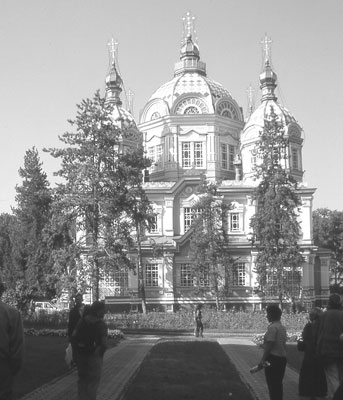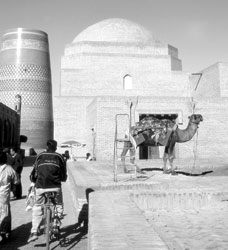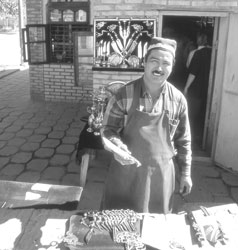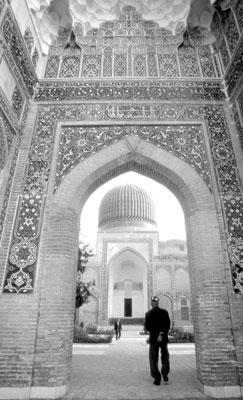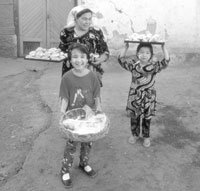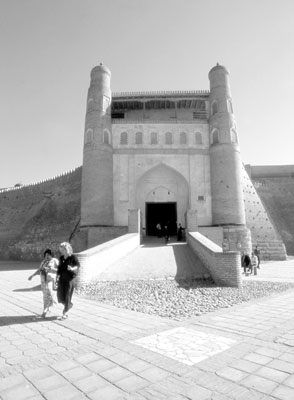Kyrgyzstan, Uzbekistan, & Turkmenistan: Following the Great Silk Road in Central Asia
by Lei Chatfield, Contributing Editor
Imagine: nomadic yurts, incredibly beautiful tiled mosques, medieval architecture and an ultramodern city created by a dictator “president” with portraits of him and his family at every turn. This mosaic is Central Asia.
Kyrgyzstan
There’s something magical about Kyrgyzstan. On our first evening in Bishkek, we were treated to a double dose of Kyrgyz culture at a local restaurant. First there was a special performance of a Kyrgyz epic legend by a master manaschi (storyteller). We were very privileged, as this is a fading art form. The elderly master was very passionate in relating the epic, and, even though we didn’t understand the language, we could understand what was going on through his expressions of elation, anger and sorrow. It was like opera without the music.
This was followed by a fashion show that even the men enjoyed. The ensembles were based on traditional Kyrgyz costumes but given a modern twist — these were very smart creations that would fit in at any formal occasion here at home.
The countryside
“What a difference a day makes” (to quote an old tune). We were venturing off to the resort town of Cholpon-Ata, where our Avrora Hotel was in a setting that in my opinion exceeded the beauty of Lake Tahoe. Snowcapped mountains here form a horseshoe around the area — breathtaking. And you will still see people living in yurts, but now they’re close enough to power lines to tap in.
En route we visited the Burana Tower, the remains of a Karakhanid minaret, and the nearby collection of Turkish stone grave markers. This was followed by a home-hosted lunch in a yurt and a demonstration of felt-rug making (I now have one in front of my family-room fireplace).
Then it was time to let the games begin. It was exciting watching teams tearing down the road on horseback. In this area known for its horsemanship, the young men were about to engage in a national sport. It’s sort of like polo but without the mallets, and the ball, which is thrown rather than hit, is the headless carcass of a goat. When I found out about this I didn’t want to watch, but another tour participant insisted. It wasn’t as bad as it sounded. And the goat, as it otherwise would be, was served for dinner to the celebrants.
The next day was a bit more subdued, with visits to Karakol Mosque, the Holy Trinity Cathedral and an easy-to-visit market with no hassles and, as always, many smiling faces.
Our last day in Kyrgyzstan, after lunch in a private home in Bishkek, featured a visit to the Children’s Craft Center, where the children performed a folklore program and we purchased some very well executed pieces of junior art. The center is funded only by the crafts and the devotion of the staff.
It would take no special encouragement to entice me back to Kyrgyzstan.
Uzbekistan
There’s so-o-o much to see in Uzbekistan, the next destination we visited on our Natural History Museum of Los Angeles tour. There’s the legendary and ancient cities of Tashkent, Samarkand and Bukhara, filled with art, architecture and backdrops for fairy tales. For shoppers, there are fine silks and pottery and immense markets with handcrafted articles where you can even find a gift for a man.
Tashkent was a whirlwind of markets, mosques and madaris (Koran schools). The blue-domed Chor-Su market is not to be missed; it is huge and fastidiously clean and offers only the best produce. Even if you’re not shopping for food, it’s an artistic and fun place to see.
We had lunch in the courtyard of Akbar Rahimov’s home. Akbar is a major ceramic artist of the country and has a small showroom there, with most of the pieces not for sale but on display.
That evening we dined in the Applied Art Museum, an impressive Uzbek-style home built as a diplomatic residence in 1907.
Samarkand
I hate to use the trite word “awe,” but when coming upon one of the oldest existing cities in the world, that is what I felt when seeing 2,500-year-old Samarkand.
Alexander the Great and Genghis Khan came through here, and Tamerlane made it his capital. Later, as a crossroads between Asia and Europe, it shone as a trade center on the Silk Road.
For those scientifically minded, a visit to the Ulug Bek Observatory is a must. The grandson of Tamerlane, Ulug Bek developed the best medieval observatory. We saw the remains of the original giant sextant, calibrated in minutes and degrees and aligned with the meridians of the Earth.
For those more romantically inclined, we saw the 14th- to 15th-century Shakhi-Sinda Ensemble of Mausoleums. After climbing the steps to the “Stairway to Heaven,” we found beautifully tiled tombs dedicated to the three most important women in Tamerlane’s life.
Most important is Samarkand’s huge Registan Square, the political and trade center of the time. The 15th- to 17th-century tile-decorated buildings are always undergoing repair, but the majesty still is there.
Bukhara
Bukhara is overwhelming. Upon reflection, in this city boasting more than 140 architectural monuments dating from the Middle Ages, it’s hard for me to sort out the extraordinary. Here are the highlights:
• The early-10th-century Ismail Samani Mausoleum. Made of baked bricks, the intricacies of the patterns are ever changing with the light — a masterpiece of its time.
• The Ark (or Citadel), a 2,000-year-old fortress of the emirs of Bukhara which finally met its fate in recent history with the Communists. Now it is a museum that showcases noble life of the 18th and 19th centuries.
• The Poi-Kalyan Complex, which is, well, complex. The 50-meter-high Kalyan Minaret is the first thing we saw (as did Marco Polo so many centuries ago). You can climb it to the skylight rotunda if you are brave enough to make your way up in the dark to get a panoramic view. For those of us more fainthearted, it’s just a nice stroll to get to the heart of things.
The Malyan Mosque dates from the 15th century, and the Kukeldash Madrasah is the largest Koran school in Central Asia. Here you will find fine craftsmen — I wish I had had more cash, as the greenback is the accepted form of trade here; plastic was accepted at only one forward-looking merchant’s shop. (I’m sure this will change with time.) Extraordinary, to me, were the woodcarvers, who from one oblong block of wood could create a beautifully intricate folding bookstand.
• The Sitorai-Moskhi-Khosa, summer palace of the last emir of Bukhara, who ruled until he fled the Communist revolution in 1920. The 19th-century palace boasts wonderful stucco decorations, huge banquet halls and a collection of costumes, silver and china. This emir was “conservative”; he had a harem of only about 400.
• A visit to a house once owned by a rich Bukharan merchant. Built in 1890, the house consisted of an external part, including a reception hall where deals of trade were carried out by men. The women’s part of the accommodation was grand. Docents gave a demonstration of how men and women of the time dressed — and the women’s clothing certainly gave new meaning to the term “layered look.”
Bukhara is nonpareil for embracing a time in Central Asian history.
Khiva
Khiva was the dessert after the heavy cultural menu. After a long drive through the Kyzyl-Kum Desert, a route on the Silk Road, we arrived at Khiva, located in the Khoresm Oasis.
This perfectly preserved walled city (a UNESCO World Heritage Site) raised visions of “The Arabian Nights.” It leaves an indelible memory. Towering minarets and a mosque with over 200 carved wooden columns are just an introduction to this ancient city filled with museums.
To stroll its cobbled streets and stay in a hotel, previously a madrasah, where you climb precarious, ancient steps to get to your room, well, that’s what travel dreams are made of.
Turkmenistan
Turkmenistan, to me, is not the garden spot of Central Asia, but it should be visited. Positioned in this hot, dusty desert land is the never-never land of Saparmurat Niyazov, who proclaims to be the beloved leader of a population largely living in poverty.
At first glance the capital of Ashkabad is quite impressive with ultramodern architecture, beautiful landscaping and broad boulevards, but on our way to the excellent museum (housed in a modern structure) we saw highrise condos that were empty because foreign investors have withdrawn. . . and the story goes on.
However, you can get a taste of the local culture, especially at the huge Sunday market where buyers and sellers come from miles around by busload, truckload and conventional auto. Here you can buy everything from wrapping paper to camels (at the close of the market, you can see camels being hoisted by crane onto vehicles for their rides home).
It was a delightful bazaar to visit as the vendors weren’t pushy, even though the customers were as they clambered to get their merchandise. And what merchandise there was in this well-organized marketplace: clothing, from everyday to elaborate costumes; housewares; jewelry; produce, and, of course, Turkmen carpets, along with an entire section of large household appliances. I was not only fascinated but exhausted after roaming through this vast maze.
We also enjoyed a visit to the textile and carpet museum, which has a carpet weighing a ton that was made by hand by 70 women.
We had a delightful farewell dinner at a “private home,” a B&B which isn’t allowed to function as a B&B after previously having been approved by the government.
This makes me appreciate what is happening in the other “Stans,” like in Uzbekistan with our excellent local tour operator, Raisa Gareeva, a woman with vision and determination. She has opened her own B&B in Bukhara (e-mail raisaslm@online.ru or visit www. salomtravel.com).
She, and Christine Robison from the Natural History Museum of Los Angeles, made me aware of the great historic and artistic heritage of this part of the world. It’s a visit I’ll never forget.
Particulars
The museum has discontinued its travel program, but fortunately the former director has established her own company offering the same exciting trips. The fascinating Central Asia journey along the Great Silk Road, including Uzbekistan, Kyrgyzstan, Kazakhstan and Turkmenistan, is scheduled for Sept. 13-Oct. 7, 2004. The 23-day tour is limited to 18 participants and costs $6,330 plus airfare. The price includes all tips, meals with wine or beer at dinner and travelers’ insurance.
For more information, contact Christine Robison at Baraka Journeys (1107 Fair Oaks Ave., Ste. 811, South Pasadena, CA 91030-3311; phone 626/799-2700 or visit www.barakajourneys.com).
Lei Chatfield was a guest of The Natural History Museum of Los Angeles.
U.S. citizens should evaluate carefully the implications for their security and safety before deciding to travel to or around Uzbekistan, the State Department advised in a Public Announcement following bombings and attacks in Tashkent and Bukhara.
Uzbek authorities confirmed that on March 28, a bomb went off in a house in the Caroman District of the Bukhara Region; authorities found large supplies of bomb-making material at the site. On March 29, two suicide bombings took place in Chorsu Bazaar in the Shakhantaur area of Tashkent; six people were killed, including the bombers, and at least 21 were wounded. During this same period, police in two other districts in Tashkent were attacked. On March 30, an explosion occurred in the vicinity of a police checkpoint on the road between Tashkent and Qibra.


